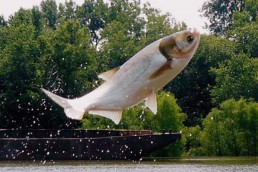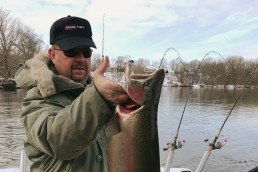Managing St. Joe River’s Invasive Asian Carp
SHARE THIS POST
The likelihood of Asian carp eggs being kept in suspension and hatching in the St. Joseph River in Michigan has been further evaluated using a model that examines a range of multiple flow and water temperature scenarios. Results illustrate the highest percentage of Asian carp eggs at risk of hatching occurs when the streamflow is low and when the water temperature is high. This new study by the University of Illinois and the U.S. Geological Survey is published in the Journal of Great Lakes Research.
“In this study, the Fluvial Egg Drift Simulator (FluEgg) model allowed us to examine the complex dependencies between flow, temperature and egg development,” said USGS hydrologist Ryan Jackson. “This information provides resource managers with a range of conditions under which the St. Joseph River is vulnerable to Asian carp reproduction.”
The FluEgg model was used to evaluate egg movement and the likelihood of successful Asian carp reproduction under different streamflow and temperature conditions representative of historical spawning seasons in the St. Joseph River, a tributary to Lake Michigan. Results show that eggs develop faster at warmer water temperatures, therefore requiring less time to drift in the river until hatching. Low streamflows can also be conducive to reproduction when the streamflow is just fast enough to keep most of the eggs in suspension while allowing for the greatest amount of drift time before reaching the lake, thus increasing the likelihood of hatching.
The FluEgg model, developed by University of Illinois researchers in collaboration with the USGS, was first introduced in 2013. The latest version of the model is available online, and includes a user-friendly interface and improved predictions of egg transport in rivers.
Invasive Asian carp consume plankton from the base of the food web and reproduce prolifically which could pose substantial environmental risks and economic impacts to the Great Lakes if they become established.
Are you enjoying this post?
You can be among the first to get the latest info on where to go, what to use and how to use it!
“This work focuses on the early life stages of Asian carp,” said USGS research fish biologist Duane Chapman. “Targeting early life stages can include disrupting spawning activities or egg development in rivers where Asian carp spawn.”
Several factors affect the viability of the eggs. The temperature of the water affects how long the eggs need to hatch, and the velocity of the river affects the movement of the eggs and whether the eggs remain in suspension or sink to the bottom. Eggs that settle on the riverbed will likely die, and eggs that are transported down the river and into a lake may not have enough time to develop to the hatching stage before settling to the lakebed.
The reproduction assessment of Asian carp eggs in the St. Joseph River demonstrated the complexity of the problem where the length of the river, velocity and water temperatures cannot be assessed individually. Rather, a holistic analysis is required, where egg development, water-quality characteristics and the hydrodynamics of the river are interconnected and analyzed together.
“Successful reproduction requires a fine balance between the rate of egg development and the variable flow conditions present in a river required to maintain the eggs in suspension,” said Tatiana Garcia, USGS research hydrologist and lead author of the paper.
The paper, “Application of the FluEgg model to predict transport of Asian carp eggs in the St. Joseph River (Great Lakes tributary)” by Tatiana Garcia, Elizabeth A. Murphy, Patrick R. Jackson and Marcelo H. Garcia, is available online.
MWO
SHARE THIS POST
Did you enjoy this post?
You can be among the first to get the latest info on where to go, what to use and how to use it!
MWO
We believe being outdoors is good. With more than 1,000 articles each year, MidWest Outdoors magazine is all about sharing outdoor experiences with you—where to go, what to use and how to use it… whether you’re close to home or on that trip of a lifetime.



